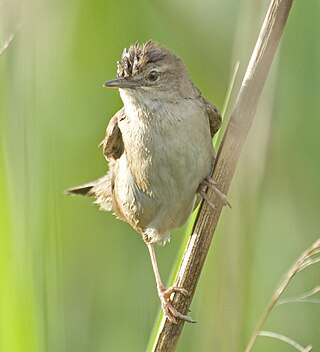
The grass warblers are small passerine birds belonging to the genus Locustella. Formerly placed in the paraphyletic "Old World warbler" assemblage, they are now considered the northernmost representatives of a largely Gondwanan family, the Locustellidae.

Tree warblers are medium-sized warblers in the marsh- and tree-warbler family Acrocephalidae. They are found in Europe, Africa and western Asia. Until recently, they were all classified in the single genus Hippolais.
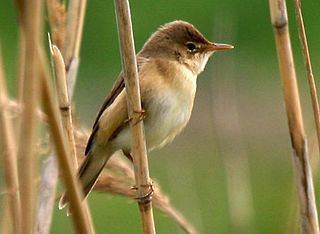
The common reed warbler is an Old World warbler in the genus Acrocephalus. It breeds across Europe into the temperate western Palaearctic where it is migratory, wintering in sub-Saharan Africa. It is also a resident species over large parts of Africa.

The sedge warbler is an Old World warbler in the genus Acrocephalus. It is a medium-sized warbler with a brown, streaked back and wings and a distinct pale supercilium. Sedge warblers are migratory, crossing the Sahara to get from their European and Asian breeding grounds to spend winter in Africa. The male's song is composed of random chattering phrases and can include mimicry of other species. The sedge warbler is mostly insectivorous.

The aquatic warbler is an Old World warbler in the genus Acrocephalus. It breeds in temperate eastern Europe and western Asia, with an estimated population of 11,000-15,000 pairs. It is migratory, wintering in west Africa. After many years of uncertainty, the wintering grounds of much of the European population were finally discovered in Djoudj National Bird Sanctuary, Senegal, with between 5,000 and 10,000 birds present at this single site. Its south-westerly migration route means that it is regular on passage as far west as Great Britain and Ireland.

The marsh warbler is an Old World warbler currently classified in the family Acrocephalidae. It breeds in temperate Europe and the western Palearctic and winters mainly in southeast Africa. It is notable for incorporating striking imitations of a wide variety of other birds into its song.
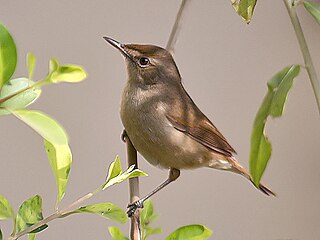
Blyth's reed warbler is an Old World warbler in the genus Acrocephalus. It breeds in the Palearctic and easternmost Europe. It is migratory, wintering in Bangladesh, India and Sri Lanka. It is one of the most common winter warblers in those countries. It is a rare vagrant to western Europe.

The great reed warbler is a Eurasian bird in the passerine genus Acrocephalus.

The thick-billed warbler breeds in the temperate east Palearctic, from south Siberia to west Mongolia. It is migratory, wintering in tropical South Asia and South-east Asia. It is a very rare vagrant to western Europe.
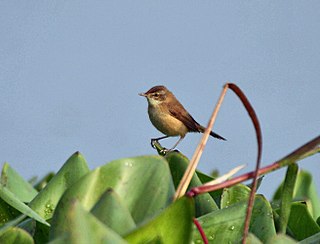
The paddyfield warbler is a species of marsh warbler. It was formerly included in the "Old World warbler" assemblage. The Manchurian reed warbler was included in A. agricola as a subspecies.

The moustached warbler is an Old World warbler in the genus Acrocephalus. It breeds in southern Europe and southern temperate Asia with a few breeding in north-west Africa. It is partially migratory. South-west European birds are resident, south-east European birds winter in the Mediterranean breeding range, and the Asiatic race migrates to Arabia, India and Pakistan.

The Tahiti reed warbler is a songbird in the genus Acrocephalus. It used to be placed in the "Old World warbler" assemblage (Sylviidae), but is now in the newly recognized marsh warbler family Acrocephalidae. It is endemic to the island of Tahiti.
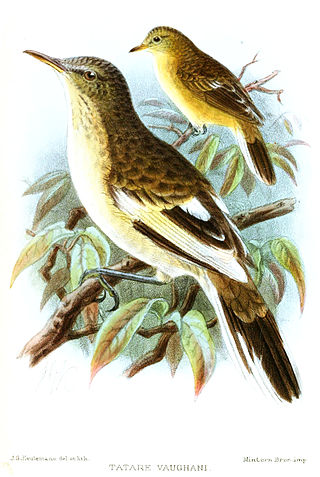
The Pitcairn reed warbler is a songbird in the genus Acrocephalus. Formerly placed in the "Old World warbler" assemblage (Sylviidae), it is now in the newly recognized marsh-warbler family Acrocephalidae.

The Acrocephalidae are a family of oscine passerine birds, in the superfamily Sylvioidea.

The Manchurian reed warbler, also known as the Manchurian reed-warbler, is a species of marsh-warbler. It was formerly included in the "Old World warbler" assemblage, and was usually treated as a subspecies of the paddyfield warbler. It is found in Cambodia, China, Hong Kong, South Korea, Laos, Russia, Thailand, Vietnam, Malaysia and possibly Myanmar. Its natural habitat is swamps. It is threatened by habitat loss.

The Oriental reed warbler is a passerine bird of eastern Asia belonging to the reed warbler genus Acrocephalus. It was formerly classified as a subspecies of the great reed warbler of the western Palearctic.
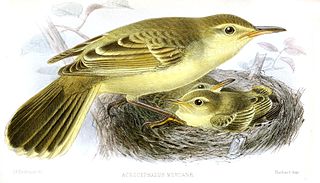
The southern Marquesan reed warbler is a species of Old World warbler in the family Acrocephalidae.

The northern Marquesan reed warbler is a species of Old World warbler in the family Acrocephalidae. It was formerly considered conspecific with the southern Marquesan reed warbler, and together known as the Marquesan reed warbler. It is found on the northern Marquesas Islands.

Garrett's reed warbler, sometimes called Society Islands reed warbler or Forster's reed-warbler was a songbird in the genus Acrocephalus. Formerly placed in the "Old World warbler" assemblage (Sylviidae), it is now in the newly recognized marsh warbler family Acrocephalidae. It was endemic to Raiatea and Huahine in the Society Islands.

The Nauru reed warbler is a passerine bird endemic to the island of Nauru in the Pacific Ocean. It is one of only two native breeding land-birds on Nauru and it is the only passerine found on the island. It is related to other Micronesian reed warblers, all of which evolved from one of several radiations of the genus across the Pacific. Related warblers on nearby islands include the Caroline reed warbler, with which the Nauru species was initially confused, and the nightingale reed warbler, which was formerly sometimes considered the same species.





















